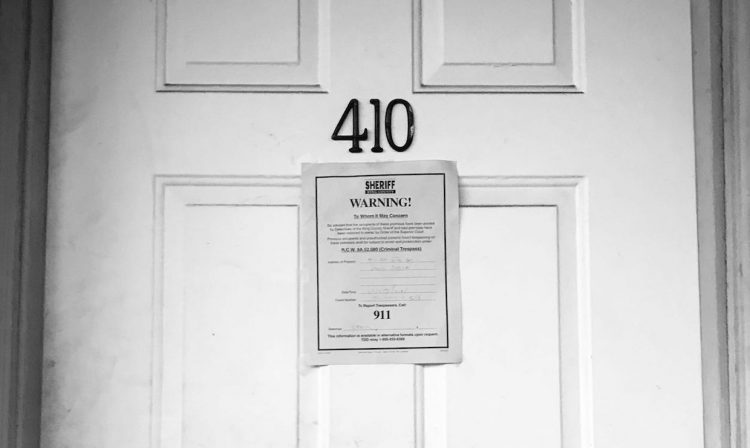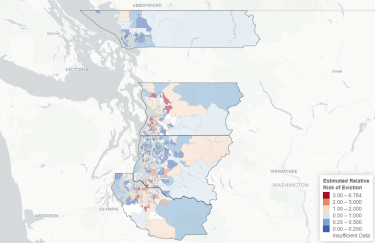
A study and interactive maps from the University of Washington and the University of California, Berkeley, show eviction totals for each of Washington's 39 counties, as well as racial disparities in evictions.UW Evictions Study
A new University of Washington study of evictions around the state shows that more women are evicted than men, and in the state's two most populous counties, eviction rates among black and Latinx adults are almost seven times higher than for white adults.
The disparities are among the findings in the Evictions Study, created by a team of UW researchers and led by Tim Thomas, a former UW postdoctoral researcher now at the University of California, Berkeley. Based on eviction filings from each of Washington's 39 counties, the report and its series of interactive maps illustrate where, and to whom, evictions hit hardest.
The surrounding narrative addresses why, and what may be done about it.
"By collecting all this data, we wanted to provide the public with an in-depth look at eviction trends at a geographical level in the region," said Jose Hernandez, a data scientist at the UW eScience Institute and the university's lead on the Evictions Study. "The hope is that the information sheds light on a problem happening in people's backyards, and that folks begin having a discussion about solutions while not ignoring evictions and their intersection with race and social class."
Eviction - the forcible removal of a tenant, usually due to unpaid rent - starts with a filing in court by a landlord. The process of notification, response and hearing before a judge is generally the same across the country, but how much time tenants are given to respond, for example, can vary by state.
Eviction data are not easily accessible. A few localized studies in other communities are tackling eviction trends, and a national effort, the Eviction Lab at Princeton University, has attempted to assemble data from 48 states. However, several states, such as Washington, are undercounted in these efforts. The Evictions Study fills in the gaps using data science to mine court records, demographic estimations to enumerate individuals, and sociological theory to explain trends.
The UW effort involved drilling down on evictions in specific areas through multiple sources of data, starting with Washington state. The city of Baltimore is next, and researchers have begun work with advocacy organizations in Connecticut, Cincinnati and Chicago.
The team first turned to eviction filings in Washington State Superior Court to obtain eviction counts by county. To put the numbers in context and analyze other potentially contributing factors, researchers used population, rental, income and housing market data from the U.S. Census Bureau's American Community Survey, as well as information from the U.S. Department of Housing and Urban Development and the annual regional Point in Time counts of homelessness.
Armed with the most detail from four counties - King, Pierce, Snohomish and Whatcom - the research team released interactive maps for those counties and hopes to produce more as additional data becomes available. Users can filter by geography (census tract, municipality or county) and race to see a variety of data sets, including the percentage of renters, median household income and eviction counts.

This map shows the relative risk of evictions across the Puget Sound area. Click on the image to view more maps.UW Evictions Study
For example, a look at the municipality view of King County and the eviction rate by race reveals higher rates of eviction among people of color in South King County.
"Our research shows that evictions are pervasive, where between 2013 and 2017, 1 in 55 Washington adults were named in an eviction filing - over 400,000 adults between 2004 and 2017," said Thomas. "The most concerning finding is the severe over-representation of black adults in the Western Washington eviction filing process. In Pierce County, 1 in 6 black adults were named in a filing between 2013 and 2017, and 1 in 11 in King County during that same time. For whites, it's 1 in 55 and 1 in 100, respectively. This severe racial disparity makes evictions a civil rights issue, requiring new laws to intervene."
The growing homelessness crisis in Seattle has focused attention on where and how people are living on the street, what services and programs can provide permanent solutions, and who will pay to fix the situation.
But what's often missing in the discussion, Thomas and the research team agree, are the factors that contribute to homelessness in the first place. Studies have shown that a person who is evicted has a 1 in 5 chance of ending up homeless; the UW study points to the connections among housing affordability, evictions and homelessness.
According to the study, in 2017, 46% of Washington households were "rent burdened," meaning that almost a one-third of household income was spent on rent. In 2019, the average monthly rent statewide reached $1,000, so a tenant would need to make $40,000 to pay that bill. In King County, however, the average rent is often more than twice the statewide average: To avoid rent burden, then, a tenant would need to make $90,000 to pay a $2,250 bill.
But evictions tend to occur in neighborhoods that are the most racially diverse and where rents are lower, especially if those neighborhoods are near higher-income areas, Thomas said. There, landlords may be willing to get rid of tenants who fall behind in rent, because there's likely to be another tenant ready to take their place.
Among the Evictions Study's findings:
- Across Washington state, 1.8% of adults were evicted between 2013 and 2017. That compares to about 2.3% nationwide, according to the Eviction Lab.
- The relative risk of eviction - the probability of an eviction in a given county versus the rest of the state - is higher in Pierce, Cowlitz and Benton counties.
- In counties with fewer than 700 evictions annually - the majority of counties in Washington - women are evicted 11% more than men.
- Black adults in King and Pierce County make up a disproportionate number of the eviction filings relative to their population. Between 2013 and 2017, 9% of King County's black adults faced an eviction, but made up 5.5% of the county's total population; in Pierce, 18% of black adults faced an eviction, while they made up 6.6% of the population.
- In both counties, when eviction data is broken down by race and ethnicity, Asian adults had the fewest evictions.
The disparities are significant, Thomas said, because they relate to historic patterns of discrimination.
"Most of King County's eviction filings occur in South King County, where households of color have been displaced from Seattle. In Pierce County, some of the highest risks of eviction occur in formerly redlined neighborhoods," Thomas said. "This link between evictions, the legacy of segregation, and gentrification can't be ignored and requires further investigation."
As the study was in the works last year, Thomas worked with regional housing advocates and Democratic legislators to successfully promote eviction reform in Olympia. Senate Bill 5600 extended the "pay-or-vacate" deadline for tenants to pay rent, from three to 14 days.
In recent weeks, Evictions Study data was part of a regional report, the Young Adult Eviction Prevention Project, produced by the King County Bar Association's Housing Justice Project and the Legal Counsel for Youth and Children. UW research found that 4% of King County renters between the ages of 18 and 24 have faced an eviction; among the report's recommendations are improved access to legal services for young people, and more resources to educate them on their rights as tenants.
Co-authors on the Evictions Study are Ott Toomet, a lecturer in the UW Information School; Ian Kennedy, a graduate student in sociology, and Alex Ramiller, a graduate student in geography, both at the UW; and Anisha Keshavan, a data scientist at Octave Bioscience who worked on the study while a postdoctoral fellow at the UW.
The study was funded by Cascade Urban Analytic Cooperative, the eScience Institute, the Bill and Melinda Gates Foundation, Microsoft Research, and Enterprise Community Partners, with technological support from the UW Center for Studies in Demography and Ecology.






